Child Mortality: Strategies to Meet the Target
VerifiedAdded on 2023/06/07
|9
|2392
|330
AI Summary
This essay discusses child mortality, its importance for health, statistics supporting the argument, strategies utilized and currently being utilized to ensure the target is met, and suggestions for what could be done to help the target be met.
Contribute Materials
Your contribution can guide someone’s learning journey. Share your
documents today.

Running head: ESSAY 1
Essay
Student’s Name
Institutional Affiliation
Essay
Student’s Name
Institutional Affiliation
Secure Best Marks with AI Grader
Need help grading? Try our AI Grader for instant feedback on your assignments.
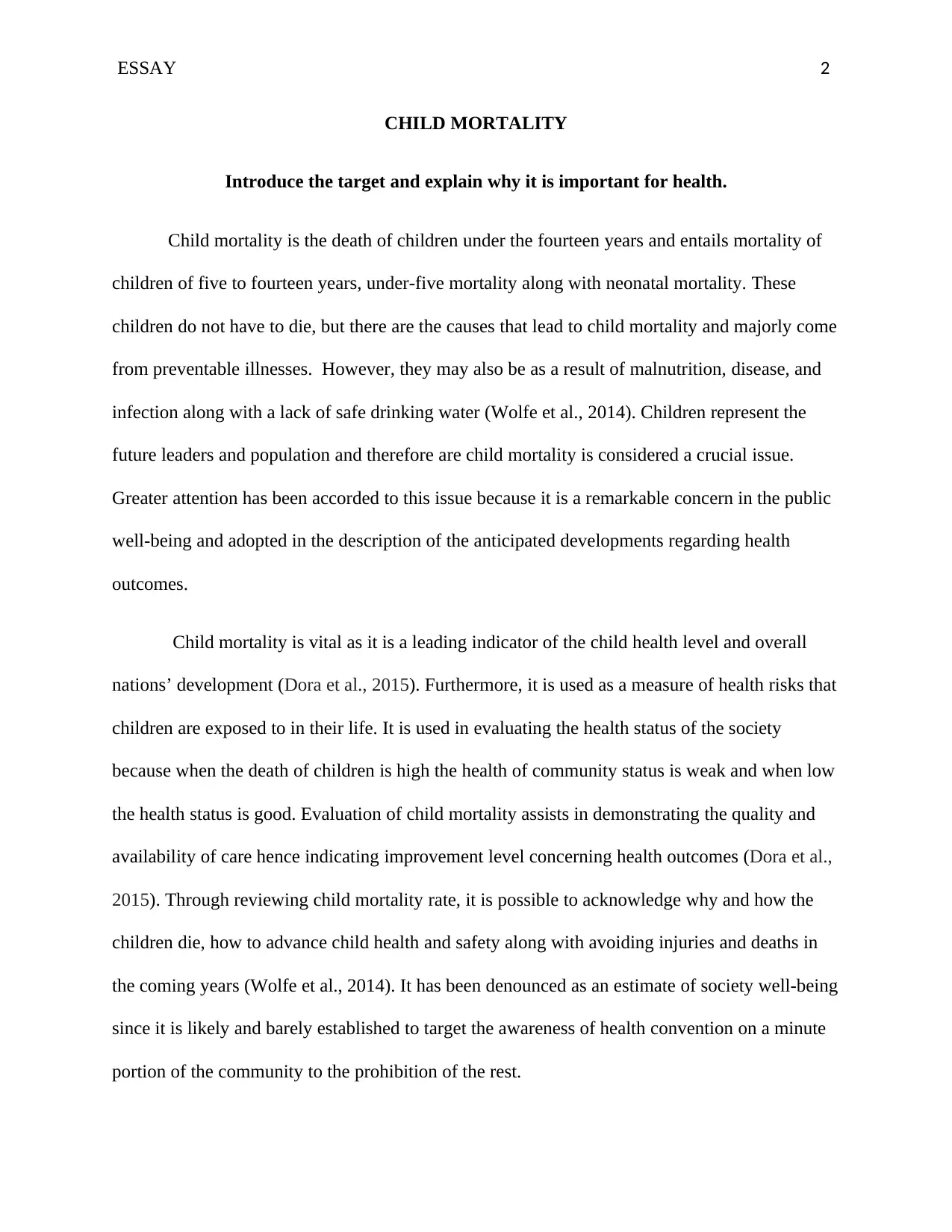
ESSAY 2
CHILD MORTALITY
Introduce the target and explain why it is important for health.
Child mortality is the death of children under the fourteen years and entails mortality of
children of five to fourteen years, under-five mortality along with neonatal mortality. These
children do not have to die, but there are the causes that lead to child mortality and majorly come
from preventable illnesses. However, they may also be as a result of malnutrition, disease, and
infection along with a lack of safe drinking water (Wolfe et al., 2014). Children represent the
future leaders and population and therefore are child mortality is considered a crucial issue.
Greater attention has been accorded to this issue because it is a remarkable concern in the public
well-being and adopted in the description of the anticipated developments regarding health
outcomes.
Child mortality is vital as it is a leading indicator of the child health level and overall
nations’ development (Dora et al., 2015). Furthermore, it is used as a measure of health risks that
children are exposed to in their life. It is used in evaluating the health status of the society
because when the death of children is high the health of community status is weak and when low
the health status is good. Evaluation of child mortality assists in demonstrating the quality and
availability of care hence indicating improvement level concerning health outcomes (Dora et al.,
2015). Through reviewing child mortality rate, it is possible to acknowledge why and how the
children die, how to advance child health and safety along with avoiding injuries and deaths in
the coming years (Wolfe et al., 2014). It has been denounced as an estimate of society well-being
since it is likely and barely established to target the awareness of health convention on a minute
portion of the community to the prohibition of the rest.
CHILD MORTALITY
Introduce the target and explain why it is important for health.
Child mortality is the death of children under the fourteen years and entails mortality of
children of five to fourteen years, under-five mortality along with neonatal mortality. These
children do not have to die, but there are the causes that lead to child mortality and majorly come
from preventable illnesses. However, they may also be as a result of malnutrition, disease, and
infection along with a lack of safe drinking water (Wolfe et al., 2014). Children represent the
future leaders and population and therefore are child mortality is considered a crucial issue.
Greater attention has been accorded to this issue because it is a remarkable concern in the public
well-being and adopted in the description of the anticipated developments regarding health
outcomes.
Child mortality is vital as it is a leading indicator of the child health level and overall
nations’ development (Dora et al., 2015). Furthermore, it is used as a measure of health risks that
children are exposed to in their life. It is used in evaluating the health status of the society
because when the death of children is high the health of community status is weak and when low
the health status is good. Evaluation of child mortality assists in demonstrating the quality and
availability of care hence indicating improvement level concerning health outcomes (Dora et al.,
2015). Through reviewing child mortality rate, it is possible to acknowledge why and how the
children die, how to advance child health and safety along with avoiding injuries and deaths in
the coming years (Wolfe et al., 2014). It has been denounced as an estimate of society well-being
since it is likely and barely established to target the awareness of health convention on a minute
portion of the community to the prohibition of the rest.

ESSAY 3
- Provide an in-depth discussion about whether the target is on track, and include relevant
statistics that support your argument.
The 2016 local child mortality rate is on track to halve the gap by 2018. Over the
extended period between 1998 and 2016, the native child mortality has decreased substantially,
and the gap has diminished (Di Natale, 2015). Consequently, the development has decelerated on
account of the objective guideline of 2018. Developments in the current years in local child
fitness results show extra possible depletions in the rate of child mortality in future. There has
been significant progress in reducing child mortality rate in the past many years. The global
under-five mortality between 1998 and 2016 has decreased from 217 deaths per 1000 live births
to 146 deaths per 1000 live births an approximation of about 35 % reduction (Di Natale, 2015).
Also, a substantial decrease of the child mortality gap by 32 % was noticed. Currently, the
advancement has decelerated with a reduction in native child mortality rate by 11.5 %. Over this
duration, the non-indigenous child mortality rate has reduced by 33 %, and therefore the
alteration of the gap not substantial.
Between 2012 and 2016 about 82 % deaths of local children were infant deaths and the
natural infant mortality rate was nearly double the non-local rate between that is 1.9 times. 53 %
deaths in this group were as a result of perinatal conditions like complications of pregnancy,
respiratory and cardiovascular illnesses, birth trauma and fetal growth disorders. By the time
1998 to 2016 the local infant mortality rate reduced substantially from 13.5 deaths per 1,000 live
births to 6 deaths per 1,000 live births of about 66.7 % and the gap narrowed by 84.5 % (Di
Natale, 2015). From 2008, a decrease in indigenous infant mortality rate by around 10 % has
been identified.
- Provide an in-depth discussion about whether the target is on track, and include relevant
statistics that support your argument.
The 2016 local child mortality rate is on track to halve the gap by 2018. Over the
extended period between 1998 and 2016, the native child mortality has decreased substantially,
and the gap has diminished (Di Natale, 2015). Consequently, the development has decelerated on
account of the objective guideline of 2018. Developments in the current years in local child
fitness results show extra possible depletions in the rate of child mortality in future. There has
been significant progress in reducing child mortality rate in the past many years. The global
under-five mortality between 1998 and 2016 has decreased from 217 deaths per 1000 live births
to 146 deaths per 1000 live births an approximation of about 35 % reduction (Di Natale, 2015).
Also, a substantial decrease of the child mortality gap by 32 % was noticed. Currently, the
advancement has decelerated with a reduction in native child mortality rate by 11.5 %. Over this
duration, the non-indigenous child mortality rate has reduced by 33 %, and therefore the
alteration of the gap not substantial.
Between 2012 and 2016 about 82 % deaths of local children were infant deaths and the
natural infant mortality rate was nearly double the non-local rate between that is 1.9 times. 53 %
deaths in this group were as a result of perinatal conditions like complications of pregnancy,
respiratory and cardiovascular illnesses, birth trauma and fetal growth disorders. By the time
1998 to 2016 the local infant mortality rate reduced substantially from 13.5 deaths per 1,000 live
births to 6 deaths per 1,000 live births of about 66.7 % and the gap narrowed by 84.5 % (Di
Natale, 2015). From 2008, a decrease in indigenous infant mortality rate by around 10 % has
been identified.
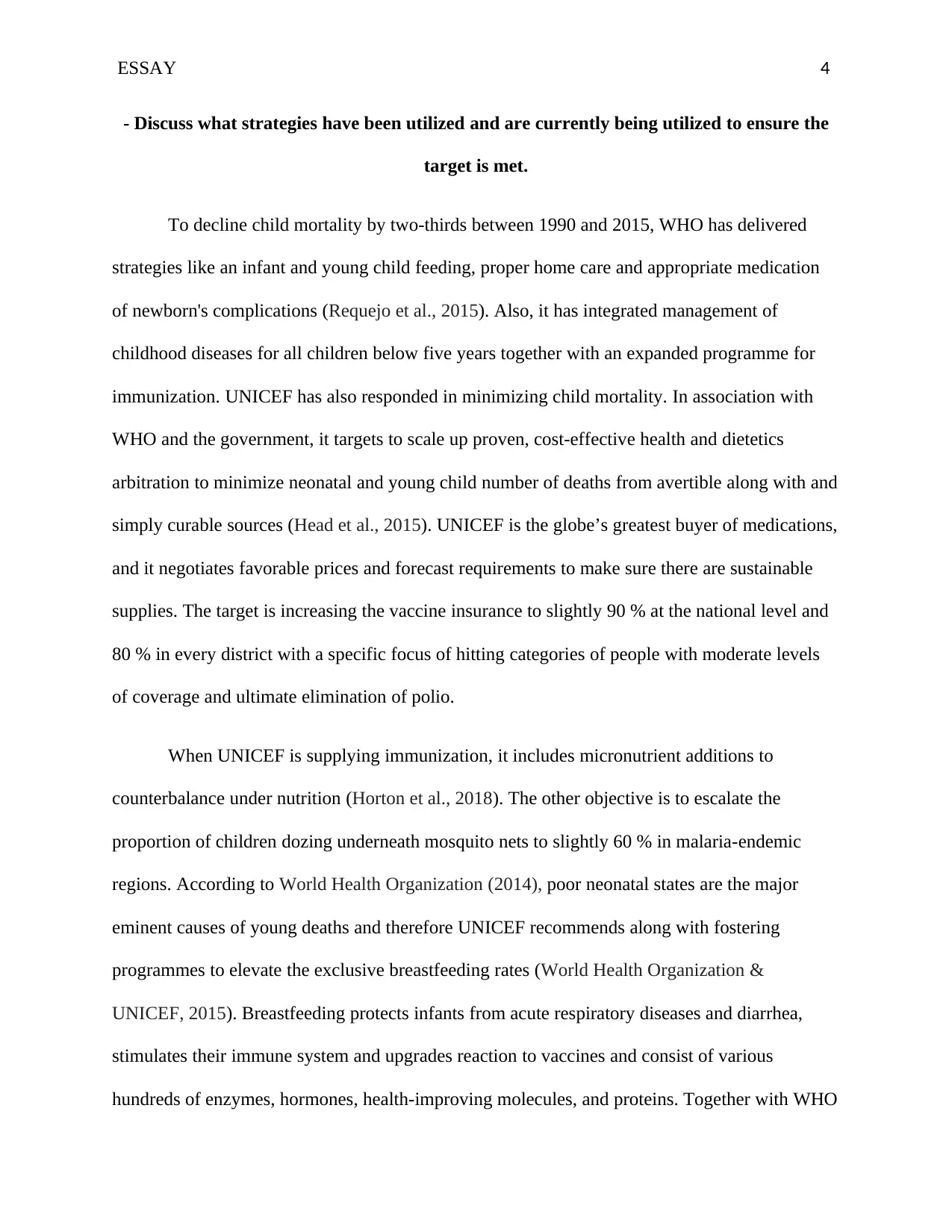
ESSAY 4
- Discuss what strategies have been utilized and are currently being utilized to ensure the
target is met.
To decline child mortality by two-thirds between 1990 and 2015, WHO has delivered
strategies like an infant and young child feeding, proper home care and appropriate medication
of newborn's complications (Requejo et al., 2015). Also, it has integrated management of
childhood diseases for all children below five years together with an expanded programme for
immunization. UNICEF has also responded in minimizing child mortality. In association with
WHO and the government, it targets to scale up proven, cost-effective health and dietetics
arbitration to minimize neonatal and young child number of deaths from avertible along with and
simply curable sources (Head et al., 2015). UNICEF is the globe’s greatest buyer of medications,
and it negotiates favorable prices and forecast requirements to make sure there are sustainable
supplies. The target is increasing the vaccine insurance to slightly 90 % at the national level and
80 % in every district with a specific focus of hitting categories of people with moderate levels
of coverage and ultimate elimination of polio.
When UNICEF is supplying immunization, it includes micronutrient additions to
counterbalance under nutrition (Horton et al., 2018). The other objective is to escalate the
proportion of children dozing underneath mosquito nets to slightly 60 % in malaria-endemic
regions. According to World Health Organization (2014), poor neonatal states are the major
eminent causes of young deaths and therefore UNICEF recommends along with fostering
programmes to elevate the exclusive breastfeeding rates (World Health Organization &
UNICEF, 2015). Breastfeeding protects infants from acute respiratory diseases and diarrhea,
stimulates their immune system and upgrades reaction to vaccines and consist of various
hundreds of enzymes, hormones, health-improving molecules, and proteins. Together with WHO
- Discuss what strategies have been utilized and are currently being utilized to ensure the
target is met.
To decline child mortality by two-thirds between 1990 and 2015, WHO has delivered
strategies like an infant and young child feeding, proper home care and appropriate medication
of newborn's complications (Requejo et al., 2015). Also, it has integrated management of
childhood diseases for all children below five years together with an expanded programme for
immunization. UNICEF has also responded in minimizing child mortality. In association with
WHO and the government, it targets to scale up proven, cost-effective health and dietetics
arbitration to minimize neonatal and young child number of deaths from avertible along with and
simply curable sources (Head et al., 2015). UNICEF is the globe’s greatest buyer of medications,
and it negotiates favorable prices and forecast requirements to make sure there are sustainable
supplies. The target is increasing the vaccine insurance to slightly 90 % at the national level and
80 % in every district with a specific focus of hitting categories of people with moderate levels
of coverage and ultimate elimination of polio.
When UNICEF is supplying immunization, it includes micronutrient additions to
counterbalance under nutrition (Horton et al., 2018). The other objective is to escalate the
proportion of children dozing underneath mosquito nets to slightly 60 % in malaria-endemic
regions. According to World Health Organization (2014), poor neonatal states are the major
eminent causes of young deaths and therefore UNICEF recommends along with fostering
programmes to elevate the exclusive breastfeeding rates (World Health Organization &
UNICEF, 2015). Breastfeeding protects infants from acute respiratory diseases and diarrhea,
stimulates their immune system and upgrades reaction to vaccines and consist of various
hundreds of enzymes, hormones, health-improving molecules, and proteins. Together with WHO
Secure Best Marks with AI Grader
Need help grading? Try our AI Grader for instant feedback on your assignments.
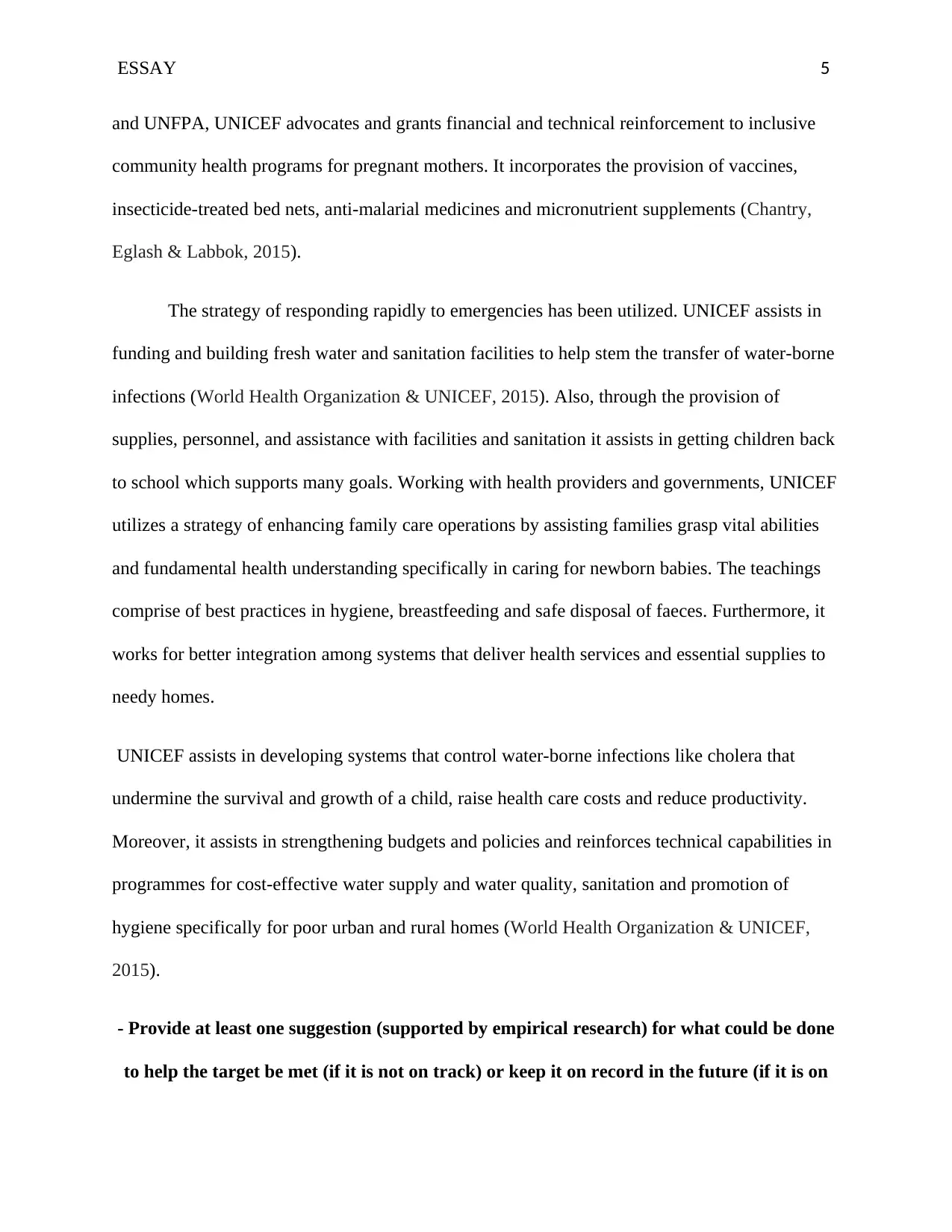
ESSAY 5
and UNFPA, UNICEF advocates and grants financial and technical reinforcement to inclusive
community health programs for pregnant mothers. It incorporates the provision of vaccines,
insecticide-treated bed nets, anti-malarial medicines and micronutrient supplements (Chantry,
Eglash & Labbok, 2015).
The strategy of responding rapidly to emergencies has been utilized. UNICEF assists in
funding and building fresh water and sanitation facilities to help stem the transfer of water-borne
infections (World Health Organization & UNICEF, 2015). Also, through the provision of
supplies, personnel, and assistance with facilities and sanitation it assists in getting children back
to school which supports many goals. Working with health providers and governments, UNICEF
utilizes a strategy of enhancing family care operations by assisting families grasp vital abilities
and fundamental health understanding specifically in caring for newborn babies. The teachings
comprise of best practices in hygiene, breastfeeding and safe disposal of faeces. Furthermore, it
works for better integration among systems that deliver health services and essential supplies to
needy homes.
UNICEF assists in developing systems that control water-borne infections like cholera that
undermine the survival and growth of a child, raise health care costs and reduce productivity.
Moreover, it assists in strengthening budgets and policies and reinforces technical capabilities in
programmes for cost-effective water supply and water quality, sanitation and promotion of
hygiene specifically for poor urban and rural homes (World Health Organization & UNICEF,
2015).
- Provide at least one suggestion (supported by empirical research) for what could be done
to help the target be met (if it is not on track) or keep it on record in the future (if it is on
and UNFPA, UNICEF advocates and grants financial and technical reinforcement to inclusive
community health programs for pregnant mothers. It incorporates the provision of vaccines,
insecticide-treated bed nets, anti-malarial medicines and micronutrient supplements (Chantry,
Eglash & Labbok, 2015).
The strategy of responding rapidly to emergencies has been utilized. UNICEF assists in
funding and building fresh water and sanitation facilities to help stem the transfer of water-borne
infections (World Health Organization & UNICEF, 2015). Also, through the provision of
supplies, personnel, and assistance with facilities and sanitation it assists in getting children back
to school which supports many goals. Working with health providers and governments, UNICEF
utilizes a strategy of enhancing family care operations by assisting families grasp vital abilities
and fundamental health understanding specifically in caring for newborn babies. The teachings
comprise of best practices in hygiene, breastfeeding and safe disposal of faeces. Furthermore, it
works for better integration among systems that deliver health services and essential supplies to
needy homes.
UNICEF assists in developing systems that control water-borne infections like cholera that
undermine the survival and growth of a child, raise health care costs and reduce productivity.
Moreover, it assists in strengthening budgets and policies and reinforces technical capabilities in
programmes for cost-effective water supply and water quality, sanitation and promotion of
hygiene specifically for poor urban and rural homes (World Health Organization & UNICEF,
2015).
- Provide at least one suggestion (supported by empirical research) for what could be done
to help the target be met (if it is not on track) or keep it on record in the future (if it is on
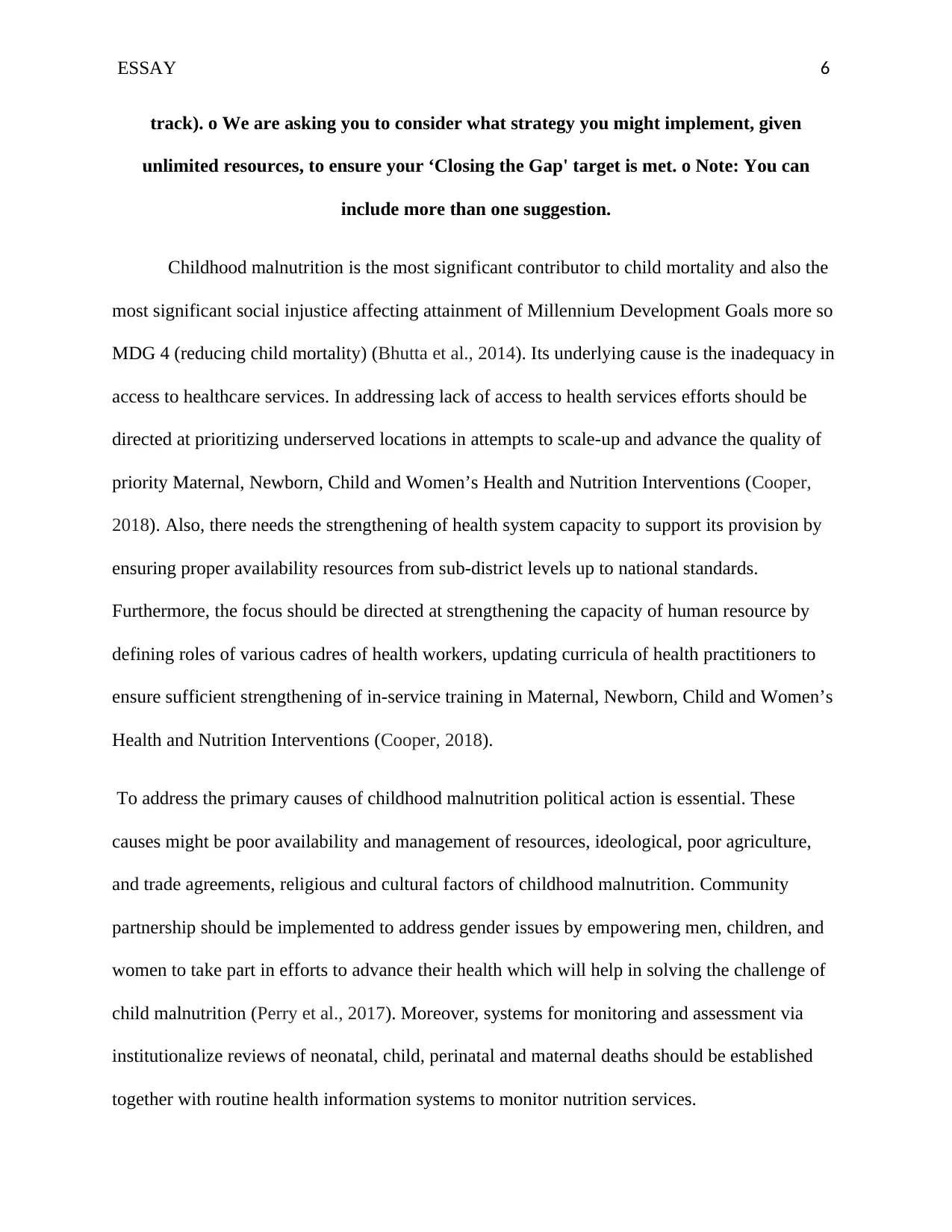
ESSAY 6
track). o We are asking you to consider what strategy you might implement, given
unlimited resources, to ensure your ‘Closing the Gap' target is met. o Note: You can
include more than one suggestion.
Childhood malnutrition is the most significant contributor to child mortality and also the
most significant social injustice affecting attainment of Millennium Development Goals more so
MDG 4 (reducing child mortality) (Bhutta et al., 2014). Its underlying cause is the inadequacy in
access to healthcare services. In addressing lack of access to health services efforts should be
directed at prioritizing underserved locations in attempts to scale-up and advance the quality of
priority Maternal, Newborn, Child and Women’s Health and Nutrition Interventions (Cooper,
2018). Also, there needs the strengthening of health system capacity to support its provision by
ensuring proper availability resources from sub-district levels up to national standards.
Furthermore, the focus should be directed at strengthening the capacity of human resource by
defining roles of various cadres of health workers, updating curricula of health practitioners to
ensure sufficient strengthening of in-service training in Maternal, Newborn, Child and Women’s
Health and Nutrition Interventions (Cooper, 2018).
To address the primary causes of childhood malnutrition political action is essential. These
causes might be poor availability and management of resources, ideological, poor agriculture,
and trade agreements, religious and cultural factors of childhood malnutrition. Community
partnership should be implemented to address gender issues by empowering men, children, and
women to take part in efforts to advance their health which will help in solving the challenge of
child malnutrition (Perry et al., 2017). Moreover, systems for monitoring and assessment via
institutionalize reviews of neonatal, child, perinatal and maternal deaths should be established
together with routine health information systems to monitor nutrition services.
track). o We are asking you to consider what strategy you might implement, given
unlimited resources, to ensure your ‘Closing the Gap' target is met. o Note: You can
include more than one suggestion.
Childhood malnutrition is the most significant contributor to child mortality and also the
most significant social injustice affecting attainment of Millennium Development Goals more so
MDG 4 (reducing child mortality) (Bhutta et al., 2014). Its underlying cause is the inadequacy in
access to healthcare services. In addressing lack of access to health services efforts should be
directed at prioritizing underserved locations in attempts to scale-up and advance the quality of
priority Maternal, Newborn, Child and Women’s Health and Nutrition Interventions (Cooper,
2018). Also, there needs the strengthening of health system capacity to support its provision by
ensuring proper availability resources from sub-district levels up to national standards.
Furthermore, the focus should be directed at strengthening the capacity of human resource by
defining roles of various cadres of health workers, updating curricula of health practitioners to
ensure sufficient strengthening of in-service training in Maternal, Newborn, Child and Women’s
Health and Nutrition Interventions (Cooper, 2018).
To address the primary causes of childhood malnutrition political action is essential. These
causes might be poor availability and management of resources, ideological, poor agriculture,
and trade agreements, religious and cultural factors of childhood malnutrition. Community
partnership should be implemented to address gender issues by empowering men, children, and
women to take part in efforts to advance their health which will help in solving the challenge of
child malnutrition (Perry et al., 2017). Moreover, systems for monitoring and assessment via
institutionalize reviews of neonatal, child, perinatal and maternal deaths should be established
together with routine health information systems to monitor nutrition services.

ESSAY 7
Conclusion.
Child mortality is a global issue and as time progresses death rates of children less than
fourteen years drop significantly. Over the long period between 1998 and 2016, the native child
mortality has decreased substantially, and the gap has reduced, and the advancement has
diminished since the 2018 objective guideline. This issue can be overcome with proper nutrition,
proper sanitary living surroundings, and proper medication. To reduce child mortality efforts
should be made to prioritize resource-poor urban settings especially in providing services.
Moreover, to develop and execute the strategy the society’s evaluations of their nutritional
challenges and the address of food security challenges should be involved.
Conclusion.
Child mortality is a global issue and as time progresses death rates of children less than
fourteen years drop significantly. Over the long period between 1998 and 2016, the native child
mortality has decreased substantially, and the gap has reduced, and the advancement has
diminished since the 2018 objective guideline. This issue can be overcome with proper nutrition,
proper sanitary living surroundings, and proper medication. To reduce child mortality efforts
should be made to prioritize resource-poor urban settings especially in providing services.
Moreover, to develop and execute the strategy the society’s evaluations of their nutritional
challenges and the address of food security challenges should be involved.
Paraphrase This Document
Need a fresh take? Get an instant paraphrase of this document with our AI Paraphraser
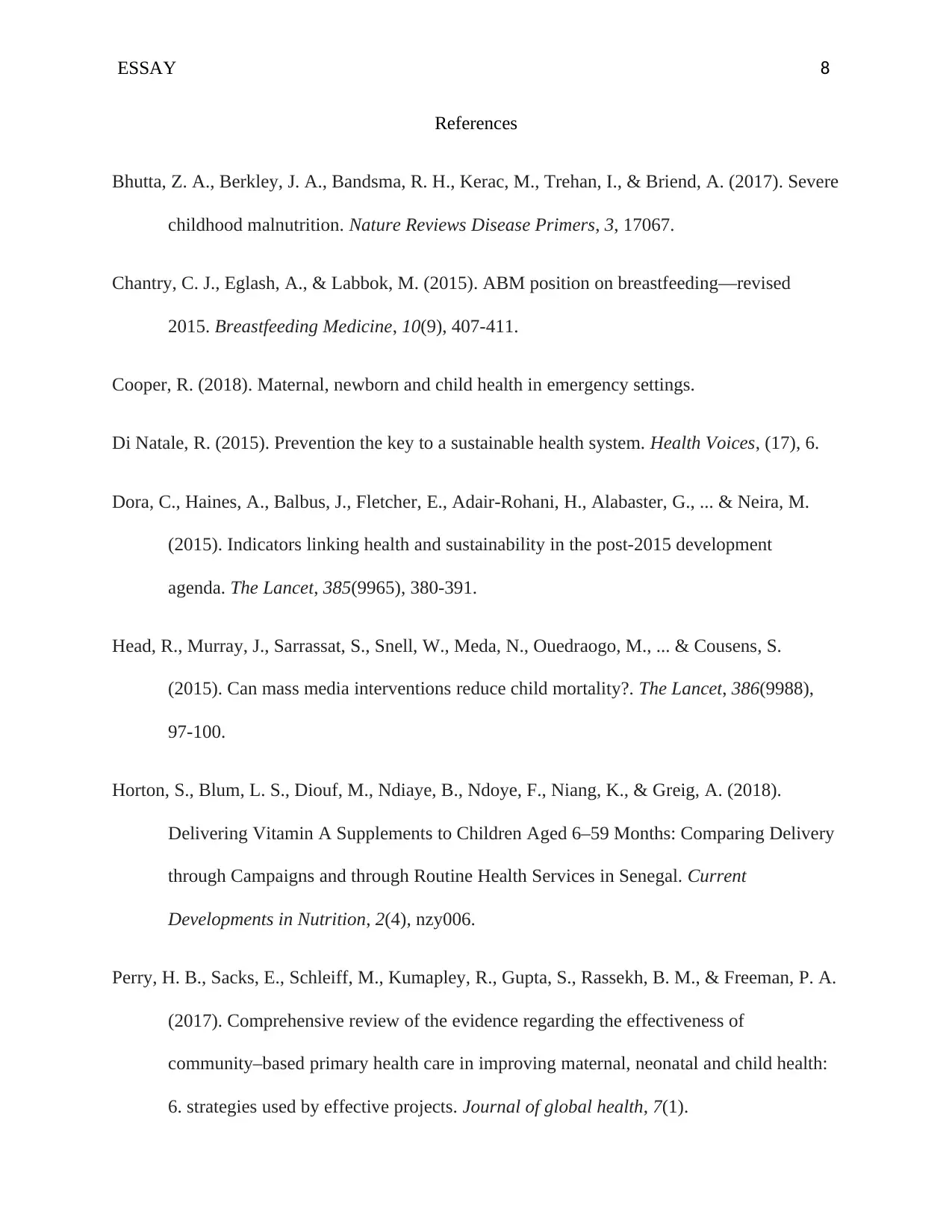
ESSAY 8
References
Bhutta, Z. A., Berkley, J. A., Bandsma, R. H., Kerac, M., Trehan, I., & Briend, A. (2017). Severe
childhood malnutrition. Nature Reviews Disease Primers, 3, 17067.
Chantry, C. J., Eglash, A., & Labbok, M. (2015). ABM position on breastfeeding—revised
2015. Breastfeeding Medicine, 10(9), 407-411.
Cooper, R. (2018). Maternal, newborn and child health in emergency settings.
Di Natale, R. (2015). Prevention the key to a sustainable health system. Health Voices, (17), 6.
Dora, C., Haines, A., Balbus, J., Fletcher, E., Adair-Rohani, H., Alabaster, G., ... & Neira, M.
(2015). Indicators linking health and sustainability in the post-2015 development
agenda. The Lancet, 385(9965), 380-391.
Head, R., Murray, J., Sarrassat, S., Snell, W., Meda, N., Ouedraogo, M., ... & Cousens, S.
(2015). Can mass media interventions reduce child mortality?. The Lancet, 386(9988),
97-100.
Horton, S., Blum, L. S., Diouf, M., Ndiaye, B., Ndoye, F., Niang, K., & Greig, A. (2018).
Delivering Vitamin A Supplements to Children Aged 6–59 Months: Comparing Delivery
through Campaigns and through Routine Health Services in Senegal. Current
Developments in Nutrition, 2(4), nzy006.
Perry, H. B., Sacks, E., Schleiff, M., Kumapley, R., Gupta, S., Rassekh, B. M., & Freeman, P. A.
(2017). Comprehensive review of the evidence regarding the effectiveness of
community–based primary health care in improving maternal, neonatal and child health:
6. strategies used by effective projects. Journal of global health, 7(1).
References
Bhutta, Z. A., Berkley, J. A., Bandsma, R. H., Kerac, M., Trehan, I., & Briend, A. (2017). Severe
childhood malnutrition. Nature Reviews Disease Primers, 3, 17067.
Chantry, C. J., Eglash, A., & Labbok, M. (2015). ABM position on breastfeeding—revised
2015. Breastfeeding Medicine, 10(9), 407-411.
Cooper, R. (2018). Maternal, newborn and child health in emergency settings.
Di Natale, R. (2015). Prevention the key to a sustainable health system. Health Voices, (17), 6.
Dora, C., Haines, A., Balbus, J., Fletcher, E., Adair-Rohani, H., Alabaster, G., ... & Neira, M.
(2015). Indicators linking health and sustainability in the post-2015 development
agenda. The Lancet, 385(9965), 380-391.
Head, R., Murray, J., Sarrassat, S., Snell, W., Meda, N., Ouedraogo, M., ... & Cousens, S.
(2015). Can mass media interventions reduce child mortality?. The Lancet, 386(9988),
97-100.
Horton, S., Blum, L. S., Diouf, M., Ndiaye, B., Ndoye, F., Niang, K., & Greig, A. (2018).
Delivering Vitamin A Supplements to Children Aged 6–59 Months: Comparing Delivery
through Campaigns and through Routine Health Services in Senegal. Current
Developments in Nutrition, 2(4), nzy006.
Perry, H. B., Sacks, E., Schleiff, M., Kumapley, R., Gupta, S., Rassekh, B. M., & Freeman, P. A.
(2017). Comprehensive review of the evidence regarding the effectiveness of
community–based primary health care in improving maternal, neonatal and child health:
6. strategies used by effective projects. Journal of global health, 7(1).

ESSAY 9
Requejo, J. H., Bryce, J., Barros, A. J., Berman, P., Bhutta, Z., Chopra, M., ... & Mason, E.
(2015). Countdown to 2015 and beyond: fulfilling the health agenda for women and
children. The Lancet, 385(9966), 466-476.
Wolfe, I. N. G. R. I. D., Macfarlane, A. L. I. S. O. N., Donkin, A. N. G. E. L. A., Marmot, M. I.
C. H. A. E. L., & Viner, R. U. S. S. E. L. L. (2014). Why children die: death in infants,
children, and young people in the UK—Part A. London: Royal College of Paediatrics
and Child Health.
World Health Organization, & UNICEF. (2015). Advocacy strategy: breastfeeding advocacy
initiative, for the best start in life.
World Health Organization, & UNICEF. (2015). Improving nutrition outcomes with better
water, sanitation, and hygiene: practical solutions for policies and programmes.
World Health Organization. (2014). Injuries and violence: the facts 2014. World Health
Organization.
Requejo, J. H., Bryce, J., Barros, A. J., Berman, P., Bhutta, Z., Chopra, M., ... & Mason, E.
(2015). Countdown to 2015 and beyond: fulfilling the health agenda for women and
children. The Lancet, 385(9966), 466-476.
Wolfe, I. N. G. R. I. D., Macfarlane, A. L. I. S. O. N., Donkin, A. N. G. E. L. A., Marmot, M. I.
C. H. A. E. L., & Viner, R. U. S. S. E. L. L. (2014). Why children die: death in infants,
children, and young people in the UK—Part A. London: Royal College of Paediatrics
and Child Health.
World Health Organization, & UNICEF. (2015). Advocacy strategy: breastfeeding advocacy
initiative, for the best start in life.
World Health Organization, & UNICEF. (2015). Improving nutrition outcomes with better
water, sanitation, and hygiene: practical solutions for policies and programmes.
World Health Organization. (2014). Injuries and violence: the facts 2014. World Health
Organization.
1 out of 9
Related Documents
Your All-in-One AI-Powered Toolkit for Academic Success.
+13062052269
info@desklib.com
Available 24*7 on WhatsApp / Email
![[object Object]](/_next/static/media/star-bottom.7253800d.svg)
Unlock your academic potential
© 2024 | Zucol Services PVT LTD | All rights reserved.





